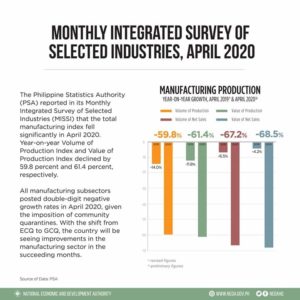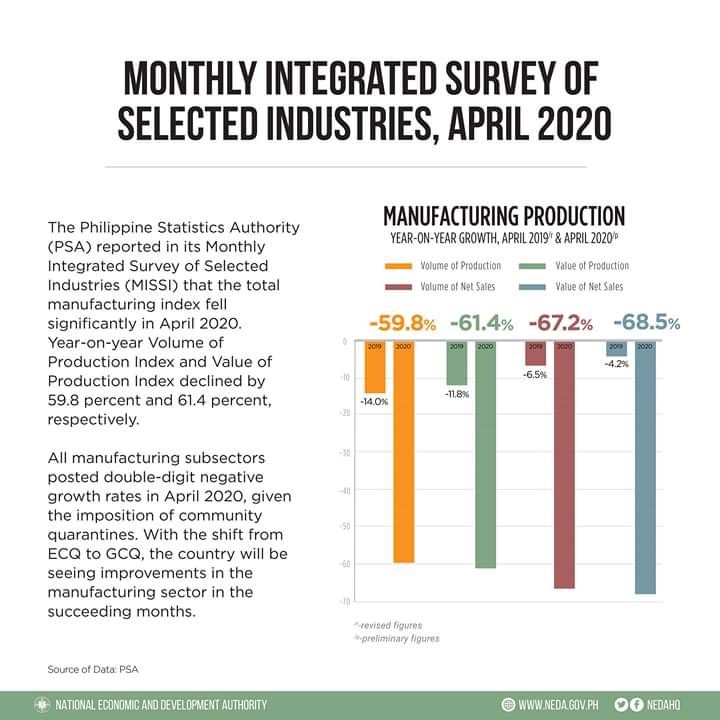
The Philippine manufacturing sector recorded double-digit declines in both volume and value in April 2020—the highest annual decline since 2001— as a result of the impact of community quarantines implemented in the country to stop the spread of the coronavirus disease (COVID-19).
According to preliminary results of the Monthly Integrated Survey of Selected Industries (MISSI) by the Philippine Statistics Authority (PSA), the Volume of Production Index (VoPI) plunged to an annual rate of 59.8% while the Value of Production Index (VaPI) plummeted at 61.4%.
The downturn in VoPI was driven by the significant decreases in indices of all industry groups, of which, three were in a very minimal business operations, namely: leather products (-99.0%), footwear and wearing apparel (-97.8%) and furniture and fixtures (-91.7%).
The decline in VaPI, on the other hand, was due to the downward movements noted in all the 20 industry groups, seven of which registered more than 85% decrements in VaPI.
These were leather products (-98.6%), footwear and wearing apparel (-98.0%), furniture and fixtures (-90.0%), fabricated metal products (-89.9%), non-metallic mineral products (-87.7%), rubber and plastic products (-87.7%) and tobacco products (-86.8%).
Socioeconomic Planning Secretary Karl Kendrick Chua, in a press briefing on June 5, attributed the significant declines in VoPI and VaPI to the impact of the enhanced community quarantine (ECQ) implemented in various parts of the country starting mid-March.
“As we shift from ECQ to GCQ [general community quarantine], we will be seeing improvements in the succeeding months,” Chua said.
The government has recently eased community quarantines nationwide and had placed Metro Manila, Regions II, III, IV-A, VII, and Pangasinan, Zamboanga City, and Davao City under GCQ starting June 1 while other areas in the country will be placed under modified GCQ.
Based on the responding establishments, PSA said the average capacity utilization rate for total manufacturing in April 2020 was posted at 70%, which was lower than the average capacity utilization rate of responding establishments in March 2020 at 77.9%.
Four of the 20 industry groups had at least 80% capacity utilization rate which was led by footwear and wearing apparel (87.4%), textiles (87.2%), rubber and plastic products (80.3%) and electrical machinery (80.1%).
More than a fifth of total responding manufacturing establishments operate at full capacity.
The proportion of establishments that operated at full capacity (90% to 100%) was more than one-fifth (23.9%) of the total number of responding establishments for manufacturing. More than two-fifths (43.1%) operated at 70% to 89% capacity while one-third (33%) operated below 70% capacity.





